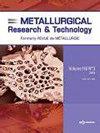Research on the variation of the inclusion and sulfur content in Pipeline steel
IF 1.1
4区 材料科学
Q3 METALLURGY & METALLURGICAL ENGINEERING
引用次数: 1
Abstract
Pipeline steel is widely used in various industries, and the sulfur content and inclusions in steel have a significant impact on performance, which determines whether the steel quality is qualified. The experiments were carried out to explore the sulfur content and inclusion evolution of pipeline steel which was deoxidized by Si–Mn–Al with “EAF-LF-VD-T-CC”. The samples of molten steel and slag were taken during the process of LF-VD-Tundish after EAF tapping. The kinetics model was established to simulate the desulfuration process of molten steel in actual production, obtaining a result which the error is within 3 ppm. It can be summarized that proper calcium treatment can transform the inclusion into a liquid inclusion, the value of [Ca] ranges from 25 to 45 ppm. Too high and lower calcium treatment can cause the compositions of inclusions to deviate from the liquid phase area, while too low calcium treatment will increase the overall size and density of the inclusions. In addition, the evolution of inclusion in steel at refining temperature and during solidification process was comprehensively calculated, considering all types of inclusions such as calcium oxide, magnesium oxide, aluminum oxide, calcium sulfide, spinel, calcium aluminate and liquid inclusion. The thermodynamic calculations are in good agreement with experimental results, which can predict the formation of the inclusions in Si–Mn–Al deoxidized pipeline steel.管道钢中夹杂物和硫含量变化的研究
管道钢广泛应用于各个行业,钢中的硫含量和夹杂物对性能有重大影响,决定了钢材质量是否合格。采用“EAF-LF-VD-T-CC”法对管道钢进行了Si-Mn-Al还原后的硫含量及夹杂物演化规律的研究。对电炉攻丝后lf - vd -中间包过程中的钢水和炉渣进行了取样。建立了动力学模型,模拟了实际生产中钢液的脱硫过程,得到了误差在3ppm以内的结果。综上所述,适当的钙处理可以使包裹体转变为液体包裹体,[Ca]的值在25 ~ 45 ppm之间。过高和过低的钙处理会使包裹体的组成偏离液相区域,过低的钙处理会使包裹体的整体尺寸和密度增大。考虑到氧化钙、氧化镁、氧化铝、硫化钙、尖晶石、铝酸钙和液体夹杂物等各类夹杂物,综合计算了钢中夹杂物在精炼温度和凝固过程中的演变规律。热力学计算与实验结果吻合较好,可以预测Si-Mn-Al脱氧管线钢中夹杂物的形成。
本文章由计算机程序翻译,如有差异,请以英文原文为准。
求助全文
约1分钟内获得全文
求助全文
来源期刊

Metallurgical Research & Technology
METALLURGY & METALLURGICAL ENGINEERING-
CiteScore
1.70
自引率
9.10%
发文量
65
审稿时长
4.4 months
期刊介绍:
Metallurgical Research and Technology (MRT) is a peer-reviewed bi-monthly journal publishing original high-quality research papers in areas ranging from process metallurgy to metal product properties and applications of ferrous and non-ferrous metals and alloys, including light-metals. It covers also the materials involved in the metal processing as ores, refractories and slags.
The journal is listed in the citation index Web of Science and has an Impact Factor.
It is highly concerned by the technological innovation as a support of the metallurgical industry at a time when it has to tackle severe challenges like energy, raw materials, sustainability, environment... Strengthening and enhancing the dialogue between science and industry is at the heart of the scope of MRT. This is why it welcomes manuscripts focusing on industrial practice, as well as basic metallurgical knowledge or review articles.
 求助内容:
求助内容: 应助结果提醒方式:
应助结果提醒方式:


